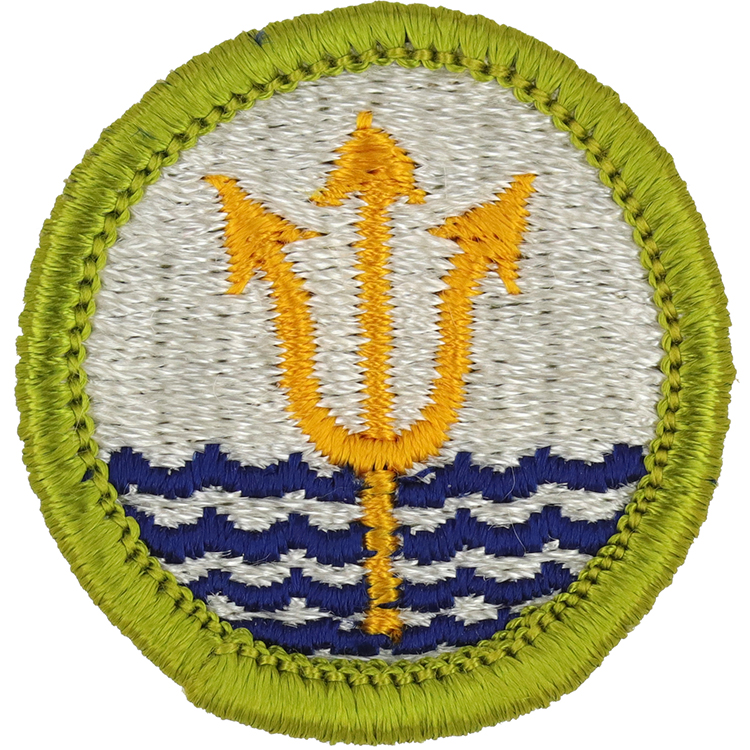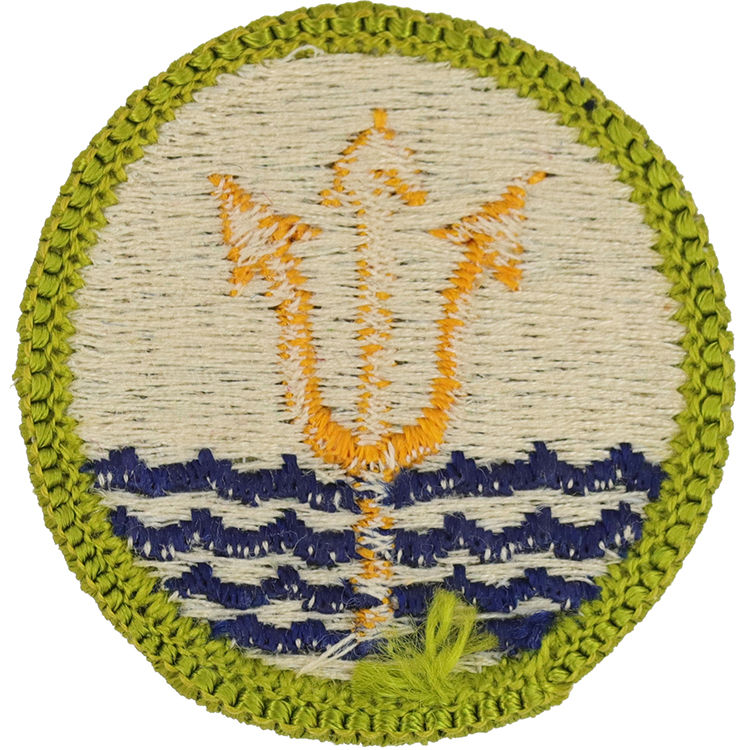
Fig. 1: Oceano-G-Front
- Embroidery: Cotton thread
- Border: Merrowed

Fig. 2: Oceano-G-Reverse
- Back: Starched cloth
Item Name: Oceanography 1964 - 1972
Item ID: Oceano-G
Collector Rating: 1
Requirements January 1965 until June 1972
1. State five branches of oceanography, and then describe at least five ways that mankind is becoming more dependent upon knowledge of the oceans.
2. Describe the effect of the oceans, including the effect of current circulation on the weather and climate. Point out the similarities and differences between the general circulation of air and ocean currents.
3. Tell how ocean waves are described. Point out the differences between the storm surge, tsunami, tidal wave, and tidal bore; also, between sea, swell, and surf. Explain how breakers are formed.
4. Draw diagram of a typical cross section of underwater topography, illustrating what is meant by the terms:
(a) Continental shelf.
(b) Continental slope.
(c) Abyssal plains.
Define and locate on your diagram the following: seamount, guyot, deep, rift valley, canyon, and trench. Compare the depth in the oceans with the heights of mountains.
5. List the principal salts, gases, and nutrients dissolved in seawater. Describe the importance of these substances to the life in the sea. What is meant by Dittmar's principle? Why is it important?
6. Define phytoplankton, zooplankton, nekton, and benthos. Describe the importance of phytoplankton as a primary producer of living material and of the position and importance of plankton in the food chain.
7. Do ONE of the following five projects:*
a) Construct a plankton net. Tow the net alongside a pier, wade with it in shallow( water, hold it in a swift tidal current, or tow it from a rowboat (with adult supervision) for approximately 20 minutes. Preserve the sample. Examine the plankton under a microscope or high-power magnifying glass. Identify the three most common types of plankton in the sample.
(b) Make a series of models (clay or plaster and wood) of a volcanic island, showing the growth cycle of an atoll from a fringing reef through a barrier reef. Describe the Darwinian theory of coral reef formation.
(c) Measure the water temperature 1 foot below the surface of a body of water or a stream four times daily (8 a.m., 12 noon, 4 p.m., 8 p.m.) for 6 consecutive days. In addition, measure the air temperature and note the cloud cover and roughness of the water. Graph the data. Show how the water responds to changes in air temperature.
(d) Make a model showing the inshore sediment movement by littoral currents, tidal movement, and wave action. Include such features as high and low waterlines, low tide terrace, cusps, beach scarp, and berm. Also, show how the offshore bars are built up and torn down.
(e) Construct a wave generator--demonstrate reflection and refraction of waves. Show how groins, jetties, and breakwaters affect these patterns.
8. Do ONE of the following three projects:
(a) Write a 500-word book report on any good book in the field of oceanography. (Verify the book beforehand with your counselor.)
(b) Visit any one of the following and write a 500-word report about your visit: (1) an oceanographic research ship, or (2) an oceanographic institute.
(c) Explain to your troop in a 5-minute prepared speech "Why Oceanography Is Important"; or, as a selected substitute, "Career Opportunities in the Science of Oceanography." (Before making your speech, submit your written speech outline to your counselor.)
* Requirements 7a or 7c may be done in lakes, streams, or ponds by Scouts living inland.

